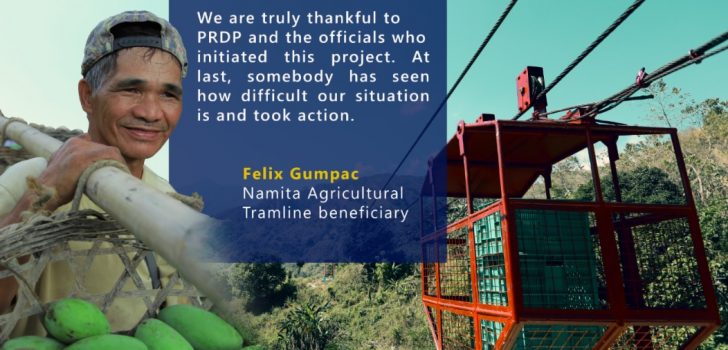
PRDP completes First Agri Tramline in Cervantes, Ilocos Sur
The Philippine Rural Development Project (PRDP) confirms the completion of the Namita Agricultural Tramline, the first of its kind, in the Municipality of Cervantes, Ilocos Sur on March 20, 2018, after the final joint inspection conducted by the national, cluster, and regional Infrastructure Components.
The tramline is proposed by the Municipality of Cervantes, Ilocos Sur to provide a safe, cheap, and fast alternative transport system of farm products and agricultural inputs from the mountainous sitios of Namita, Bulala, and Nansusuan to the nearest road network. The proposal is approved by the Regional Project Advisory Board 1 (RPAB 1) on August 30, 2016 and was issued a No Objection Letter 1 (NOL 1) on September 22, 2016.
The tramline is located at Barangay Malaya, Cervantes, Ilocos Sur with a total length of 472 lineal meters. It is expected to serve 34.55 hectares of upland agricultural land. Its total project cost is Php 4,687,049.46, including the 10 percent counterpart each from the Department of Agriculture-Government of the Philippines and the Municipality of Cervantes, Ilocos Sur, respectively.
Farmers from Sitio Namita, Bulala, and Nansusua manually haul their produce from the fields to the nearest access roads. They walk 30 minutes from the nearest area of production (or one hour from the farthest area of production) to the national road, carrying the sack containing their products on their backs. From the national road, it will take 10-15 minutes of travel by land to the market. As such, commodities are prone to spoilage and damage.
Mr. Felix Gumpac, resident of Brgy. Malaya and beneficiary of the tramline said, “We only transport products up to what our backs can carry. It is the same with farming. We only plant and grow what we can carry manually from our farm land to the nearest access road. We estimate the amount of products we can carry. Why would we plant one hectare of land with rice if we cannot carry everything to bring to the market? Also, the spoilage of our products is high even if we only carry small amounts on our backs. For instance, when we haul fruits from our farms, even if we put them in a basket, a great percentage will be bruised upon reaching the market.”
He added, “During rainy season, manually hauling our products is really difficult. Asking other people to carry our produce to the market is also expensive, depending on the distance of our farm from the access road. When we ask people to carry our rice produce, we spend around Php 60 per sack from the farthest farm lands. The price gets cheaper as the distance gets nearer, Php50, Php 40, Php 30 per sack from the nearest farm lands to the access road.”
For the farmers, the completion of the tramline is a long awaited answer to their fervent prayers.
After the tramline is formally launched, the PRDP will conduct a Rapid Appraisal of Emerging Benefits (RAEB) to assess the immediate impacts of the project to the beneficiaries. ### Dessa U. Estrada and Vida V. Cacal, RPCO 1 InfoACE Unit
